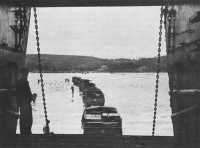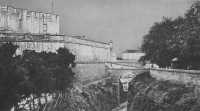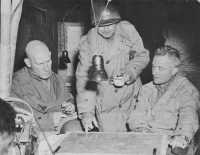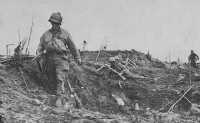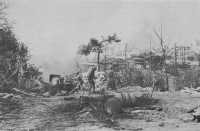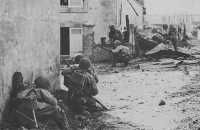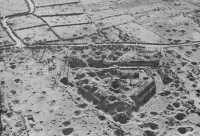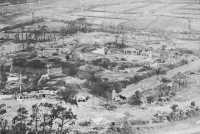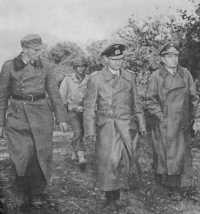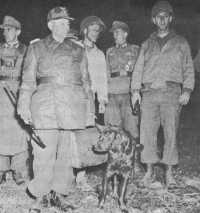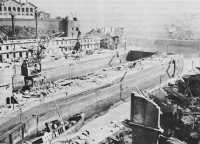Part 7: Pursuit
Blank page
Chapter 30: The Battle for Brest
The Post-OVERLORD Decision
Near the end of August the Allies could consider Operation OVERLORD virtually complete. They had secured a continental lodgment area from which to mount an assault against the heart of Germany. The next step, according to plans, was to transform the lodgment into a continental base to support the blow that was to lay the enemy prostrate and allow Allied troops to overrun the German homeland.
To prepare for the final attack toward Germany, the Allies had intended, even as late as mid-August, to halt for several weeks at the Seine.1 But developments on the battle front during the second half of August—the partial destruction of two German armies in Normandy and the landings in southern France—had prompted German withdrawal along the entire front. This made it imperative for the Allies to deny the enemy the chance to recover and make a stand at any of several terrain features along the path of retreat that were favorable for defense. Logistical considerations notwithstanding, pursuit operations had to be undertaken at once. (See Maps I, VIII, XII.)
When the Allies reached the Seine, the logistical situation was far from satisfactory. With the exception of Cherbourg, the Allies had no major ports. Pre-invasion planners had assumed that the conclusion of OVERLORD would find the Americans in possession of the Breton ports of St. Malo, Brest, Quiberon Bay, and Nantes, and the British in position to take Rouen and Le Havre.2 Although by mid-August the British could anticipate quick capture of the Seine ports and even the Channel ports, the Americans possessed only Cherbourg and the destroyed and useless harbor facilities at St. Malo. Strong German garrisons still held Brest, Lorient (and the Quiberon peninsula), and St. Nazaire (which barred the mouth of the Loire River and therefore access to Nantes). All Allied supplies were still coming across the beaches, with the exception of inconsequential quantities arriving through such minor ports as Isigny, Granville, and Cancale, and somewhat larger amounts discharged at Cherbourg. Although the tonnage landed with such limited facilities exceeded all expectations, the approach of autumn weather cast a shadow on future prospects.
The logistical apparatus on the Continent
was also deficient.3 The spectacular nature of the breakout from the cramped pre-COBRA beachhead had made it impossible for supply installations to keep up with the combat units, supply distances having suddenly changed from tens of miles to hundreds. The First Army had relinquished logistical responsibilities to the Communications Zone at the end of July, just when the demands of the static battle of the hedgerows were giving way to the different requirements of mobile warfare. The Communications Zone, instead of expanding the depot system as planned, had to assume the more pressing task of delivering supplies directly to the consumers. The result was not the most secure logistical base from which to launch post-OVERLORD operations.
Despite his awareness of the logistical flaws, General Eisenhower on 17 August felt that “the beating” the Allies were administering the enemy in Normandy would enable the Allies to “dash across the Seine.” Two days later he decided to cross the Seine in strength.4 On 20 August, while the 79th Division was securing the first Allied bridgehead over the Seine, the Allied command was giving serious consideration to the next goal—the Rhine River, more than two hundred and fifty miles to the east.5
The decision to cross the Seine necessitated little soul searching. The example of McClellan at Antietam was too well known. Pursuit of a defeated enemy was axiomatic.
General Eisenhower’s decision to pursue the enemy across the Seine changed neither the port development plans nor the prevalent feeling that the Breton ports were vital for the development of the campaign.6 According to the Allied troop dispositions and the plans for post-OVERLORD operations, the 21 Army Group would advance up the Channel coast while the 12th Army Group drove eastward away from the coast and across northern France. By liberating and opening the Seine and Channel ports, which had been reserved in the OVERLORD planning for British and Canadian logistical operations, the 21 Army Group would ease its supply problems. In contrast, the American forces would be moving away from the coast and lengthening their supply lines. Since in August Cherbourg was still handling less cargo than anticipated and since the gales of September might disrupt and even terminate the beach operations on the invasion coast, sheltered waters and port unloading facilities in Brittany, despite their increasing distance from the front, remained objectives of vital importance.
“We are promised greatly accelerated shipments of American divisions directly from the United States,” General Eisenhower explained to General Montgomery as he set forth his thoughts on pursuit
operations beyond the Seine, “and it is mandatory that we capture and prepare ports and communications to receive them. This has an importance second only to the destruction of the remaining enemy forces on our front.” The speed of Bradley’s advance east of Paris, General Eisenhower felt, would be governed by the speed with which the Breton ports could be secured and the supply situation improved.7
The opening attack on the most important of the Breton ports, Brest, coincided on 25 August with the start of the pursuit beyond the Seine. Generals Eisenhower, Bradley, and Patton anticipated quick success on both fronts, and the Supreme Commander talked of sending the VIII Corps to secure Bordeaux very soon—as soon as the Breton ports fell.8
A fortress city of 80,000 people situated on the northern shore of an excellent landlocked roadstead of ninety square miles, Brest had been a major base of the French Navy. Because it was primarily a naval base and remote from the industrial centers of France, Brest had never attained commercial importance. In World War I, the American Expeditionary Force had used it as the principal port for the direct movement of troops from the United States to France. Though the cargo-handling facilities were not as good as at other French ports, Brest offered the Allies an excellent deep water harbor. The railroad from Brest to Rennes, along the north shore of Brittany, had been captured in good condition, and supplies discharged at Brest could easily be transported to the troops in the interior of France.9
Conscious of the deficiency of unloading equipment at Brest and of the probability that the Germans would destroy all facilities before letting the port fall into Allied hands, the Allies had drawn plans for constructing a port complex at Quiberon Bay. Yet in order to use not only Quiberon but also Lorient, St. Nazaire, and Nantes, the Allies first had to clear the sea lanes around the Brittany tip—that is, eliminate the German naval base at Brest and seize the submarine pens there.10
In the same way that the Allies thought the fall of St. Malo would weaken the German will to resist at the other port cities, they hoped that the reduction of Brest would affect the morale of the garrisons at Lorient and St. Nazaire. After Brest, the Allies intended to attack Lorient “if it was still holding out.”11
Thus it came about that as the Allies plunged into pursuit of the retreating enemy east of the Seine, more than fifty thousand U.S. troops became involved in siege operations against the fortress of Brest, three hundred miles west of the front.
The Problems at Brest
Brittany had become the province of General Middleton and the VIII Corps when they entered the peninsula by way of Avranches on the first day of August. Before the first week was over, the majority of the Germans had fled the interior portions and taken refuge in ports designated by Hitler as fortresses: St. Malo, Brest, Lorient, and St. Nazaire. The only enemy forces in the interior were small detachments that hid by day and attempted to reach a fortress port by night.
Though the Germans inside the fortresses displayed little penchant for sallying forth, they had to be contained until means to eliminate them became available. Excluding those at St. Malo and a small force at Paimpol, Middleton estimated that approximately 35,000 Germans (about 10,000 field forces and 25,000 naval, marine, and miscellaneous garrison troops) remained in Brittany. He judged that about 16,000 troops (half of which were field forces) garrisoned Brest, 9,500 the Lorient area (including Concarneau and Belle-Isle), and 9,500 St. Nazaire.12 (See Map VIII.)
Middleton’s primary mission, after the fall of St. Malo, would be the capture of Brest, but the forces then available to him were insufficient for this and his other tasks. The whirlpool that was sucking Allied forces eastward to the Seine and beyond left the VIII Corps with responsibility for a widening gap between its forces in Brittany and the southern flank of the Third Army. Eventually Middleton guarded a southern flank two hundred and fifty miles long. When he received, because of a typographical error, a telegram intended for the VII Corps, telling him to “take over the Melun bridgehead” on the Seine, he replied, “Can’t do it; stretched too far already.”13
Having lost the 4th Armored Division to the XII Corps, Middleton covered the Nantes-Angers area with the 2nd Cavalry Group and a regiment of the 80th Division. He had the bulk of the 6th Armored Division at Lorient, a small combat command of the 6th and a few 8th Division troops at Brest. With Task Force A clearing the Paimpol area, the 83rd Division heavily engaged at St. Malo, and the 8th Division protecting Rennes, the capture of Brest and the protection of an ever-extending front along the Loire River were beyond the capacities of the corps. To permit the 83rd Division (upon the reduction of St. Malo) to assume the less wearing mission of patrolling the Loire River, and to reinforce the 8th Division and Task Force A scheduled for action at Brest (several thousand FFI members under Colonel Eon were also available for action on the periphery of Brest), Bradley transferred from the First Army to Middleton the 2nd and 29th Divisions, which had been pinched out near Tinchebray during the reduction of the Argentan–Falaise pocket, and two Ranger battalions, which had been performing rear-area guard duty.14
At Lorient General Grow, the 6th Armored Division commander, chafed under his static containment mission and wrote Middleton “a plea for the characteristics of the Division to be exploited to the maximum at the earliest practicable date.”15 Middleton appreciated Grow’s eagerness to get into the main operational stream outside Brittany, but considered the presence of an armored reserve essential. Grow then went to see Patton, who told Grow to move a combat command to Orléans; on the way, the troops were to clear small German groups that were still a nuisance along the Loire River. At least part of the 6th Armored Division would thus be closer to the main body of the Third Army and more quickly available to Patton. CCB started out of Brittany on 28 August, forced a small group of Germans on the north bank to evacuate to Saumur, found no other enemy forces north of the Loire River, and eventually moved to Montargis.16
Meanwhile forces gathered for the attack on Brest. The Communications Zone headquarters took responsibility for Rennes and relieved the 8th Division, which reached Plabennec by 18 August. The 2nd Division arrived at Landerneau on 19 August, and the 29th Division assembled just south of Lannilis four days later. With Task Force A and contingents of the FFI also nearby, Middleton was ready to commence his operation against Brest as soon as adequate supplies could be stocked. (Map XV.)
Adequate supplies were as much a problem for Middleton as they were for the commanders driving east from the Seine. By far the most serious shortage for the siege-type action about to take place at Brest was in artillery ammunition. The shortage was already plaguing the corps at St. Malo, and on 10 August Middleton had warned the Third Army that he foresaw heavy ammunition expenditures at Brest. Patton promised that even though the Third Army might be rationed in ammunition, he would see to it that the VIII Corps was supplied.17 When the army requested formal estimates of the Brest requirements, Middleton based his reply on the St. Malo experience and on the expectation of using an armored division and three infantry divisions supported by thirteen battalions of corps artillery. He requested an initial stock of 8,700 tons of ammunition, plus a replenishment allowance of 11,600 tons for the first three days.
The Third Army staff considered the request excessive on two grounds. It anticipated that only two divisions and ten corps artillery battalions would take part in the operation against Brest, and it believed that the corps had overestimated the strength of the enemy garrison and its will to resist. Setting 1 September as the target date for the fall of Brest, Third Army allotted only about 5,000 tons for the entire operation—less than
a quarter of what Middleton considered essential for the first three days. As it turned out, three divisions and a separate task force supported by eighteen corps artillery battalions—division artillery and tank destroyer battalions brought the total to thirty-four battalions—were eventually to take part in the battle, a force that further emphasized the discrepancy between requirements and stocks.
Third Army’s unwillingness to send more than 5,000 tons of ammunition to the VIII Corps reflected the critical nature of supply transportation for the main Third Army drive to the east. In addition, coordination between Third Army and VIII Corps was difficult because of the growing distance between the two headquarters. On 25 August the army and corps command posts were two hundred and seventy miles apart. Hoping to alleviate the difficulties, Third Army arranged to have the Brittany Base Section of the Communications Zone provide direct administrative support to VIII Corps. A slight increase in ammunition stocks resulted.
When Generals Bradley and Patton visited the VIII Corps headquarters on 23 August, General Middleton convinced them he needed more ammunition. They immediately authorized 8,000 tons, which they thought would be sufficient for six days, the length of time they considered reasonable for the operation. Expecting the ammunition to be delivered, Middleton launched his attack on 25 August. When all the authorized supplies did not arrive, he had to suspend operations. Three days later he learned that what he had regarded as minimum, Bradley and Patton had considered adequate.
As a result of better coordination, better arrangements for ship and rail transportation to the Brest area were made on 29 August. Still, not until 7 September did the corps have enough ammunition stocks to permit resumption of a sustained full-scale attack. Even then, so many agencies were involved that no one knew the exact status of supply or what was en route or on order. Hoping nevertheless that a steady flow of ammunition had been established, Middleton launched another attack on 8 September. He was not disappointed. By 10 September Bradley had assigned the Brest operation first priority on supply. When the operation finally terminated, 25,000 tons of ammunition were in the corps supply point, much of which was later reshipped to the active front, hundreds of miles away.18
The difficulties in fulfilling the VIII Corps requirements had come from intense competition among the armies engaged in the pursuit for the severely limited overland transport available. Ammunition shortages in Brittany occurred at the same time that gasoline crises affected the pursuit. The VIII Corps used the beach of St. Michel-en-Grève (near Morlaix) to receive LST-shipped items, but the seaborne cargo was not adequate to supply all needs, and trains and trucks had to bring most of the supplies to Brest from Normandy. An airfield near Morlaix was used to bring in emergency supplies and to evacuate wounded.19 Poor communications,
Supplies for Brest. Trucks leaving LST near Morlaix for Brest.
long distances, and weather contributed their adverse effects, but at the bottom of the difficulties was improper coordination for the Brest operation at all the echelons of higher command due to the optimistic initial belief that Brest would fall quickly.
Another headquarters became involved in the Brest operation on 10 September, when VIII Corps passed from Third Army control to Lt. Gen. William H. Simpson’s Ninth U.S. Army, operational five days earlier at Rennes. The Ninth Army assumed responsibility for protecting the southern flank of the 12th Army Group and for conducting operations in Brittany. In addition it had the task of receiving, processing, and training units arriving in France. General Bradley had thought of inserting the Ninth Army into the line during the pursuit east of Paris, but the speed of the advance and logistical difficulties prompted him to assign it to Brittany. To permit Middleton to give undivided attention to Brest, General Simpson placed the 6th Armored and 83rd Divisions, which were not involved at Brest, directly under his own control. Almost immediately afterwards, when Bradley called for troops to augment the forces in the pursuit, Simpson accelerated
the movement into Brittany of the 94th Division, commanded by Maj. Gen. Harry J. Malony, in order to release the 6th Armored Division. Around the middle of September, after the newly arrived division assumed the job of guarding Lorient, the 6th Armored Division finally moved eastward to rejoin the Third Army.20
The problems of getting the operation started and keeping it in motion were matched by the task of reducing the defensive complex of the fortress of Brest.21 (Map XIV) The city itself, originally on the slopes of hills on both sides of the Penfeld River, spread over several neighboring communities, among them Recouvrance and St. Pierre-Quilbignan on the west, Lambézellec on the north, St. Marc on the east. The city proper and the small commercial port area are east of the river; the western side, known as Recouvrance, includes the naval base, with extensive repair shops, drydocks, quays, barracks, storehouses, and U-boat shelter pens.
The countryside around Brest, a gently rolling plateau, presents a pattern of small hills and low ridges separated in some places by narrow deep-cut valleys, the whole criss-crossed by numerous streams. The Germans used these terrain features to good advantage and organized a system of positions of various kinds and in varying strengths to establish a defense in depth.
The defensive works ranged from simple trenches to concrete pillboxes, casemates, and gun emplacements. Obstacles included barbed wire entanglements, mine fields, and antitank ditches. The Germans incorporated into their defensive system a number of old French forts, built before the Franco-Prussian War and located in the western and northwestern suburbs of the city. Even the high ramparts of an ancient fortress at the mouth of the Penfeld, a work constructed by Vauban in the seventeenth century, had a role in the defense scheme—in some places thirty-five feet high, fifteen feet thick, and protected by a moat, overgrown with grass, vines, and flowers, and serving as a promenade for Sunday strollers, the walls sheltered gun emplacements.
The Germans integrated into their land defenses dual-purpose antiaircraft guns and guns stripped from ships sunk in the harbor by Allied planes. Batteries of coastal and field artillery on the Daoulas promontory and the Quelern peninsula provided additional fire support. Heavy guns near le Conquet, intended primarily to protect the sea approaches to Brest, could also help the landward defenses. Although the Germans considered their twelve batteries of Army field artillery and eighteen batteries of Navy Flak inadequate for the task of defending Brest, the Americans were to find them more than troublesome.22
Approximately thirty thousand troops defended Brest, nearly twice the number estimated by the Americans. The core of the defense was the 2nd Paratroop Division, composed of tough young soldiers. Their commander, Ramcke, who had gained prominence in the German airborne
Ancient Wall and Moat on land side, inner fortress at Brest.
attack on Crete in 1940, was also the fortress commander. His chief of staff was Colonel von der Mosel who, before Ramcke’s appointment, had commanded the fortress. Generalmajor Josef Rauch, the commander of the 343rd (Static) Division, was charged with the Daoulas and Crozon sectors.23
Ordered by Hitler to hold to the last man, Ramcke was determined to do so. If he needed to justify resistance that could count victory only in the number of days the garrison held out, Ramcke could feel that the Allied forces he tied down at Brest and the ammunition he caused the Allies to expend there would constitute just that much less that could be brought to bear on the German homeland. Having evacuated all the French civilians who might encumber his defense, Ramcke used his paratroopers as nuclei to stiffen the defense of strongpoints held by the miscellaneous naval and static personnel of the garrison.24
Between 13 August, when the 6th Armored Division had started to displace from Brest to Lorient, and 18 August, when the bulk of the 8th Division began to arrive near Brest, the presence of little more than a combat command of Allied troops near Brest led the German garrison to make raids on the countryside.25 These came to an end as U.S. forces gathered. On 18 August the VIII Corps command post moved one hundred and twenty miles to Lesneven, fifteen miles from Brest, to undertake the siege of the
General Middleton confers with General Simpson (left) and General Stroh (right) near Brest.
fortress. Though Bradley and Patton thought the Germans would soon capitulate, Middleton figured that Brest would be little different from St. Malo. Several days before the operation began, planners at the 12th Army Group also concluded that the Brest garrison would probably fight to the last man.26
The Fight for Brest
Even before the arrival of all his forces in the Brest area, General Middleton launched a preliminary operation designed to protect his flanks, isolate his objective, prevent the escape of the garrison across the harbor, and secure observation points on the promontory between Brest and Daoulas.27 Combining the 2nd Division’s 38th Infantry, plus additional units, with General Earnest’s long-standing Task Force A, General Middleton created a unit called Task
Force B under Brig. Gen. James A. Van Fleet, the assistant commander of the 2nd Division.28 He instructed Van Fleet to attack from Landernau to Hill 154, a dominating feature on the approaches to Brest south of the Elorn River. (See Map VIII.)
Task Force B jumped off on 21 August and advanced rapidly for several miles until stopped by a massive volume of fire from positions on Hill 154 and from artillery north of the Elorn. The defenders, soldiers of the 353rd Division, were well dug in on a strong position that included a network of trenches around the crest of the hill, eight steel and concrete reinforced pillboxes, and barbed wire entanglements. They had more than twenty-five machine guns, several antitank weapons, and mortars. The strength of the position and the fire power allocated to its defense indicated the importance the Germans attached to its possession.
Supported by tank destroyer and artillery fire, a battalion of the 38th Infantry assaulted on 23 August over rocky terrain that afforded scant cover and concealment. Success was in large part attributable to the action of Staff Sgt. Alvin P. Casey, who though mortally wounded destroyed a pillbox with grenades.29 Against a total loss of 7 dead and 28 wounded, Task Force B took 143 prisoners and counted about a hundred German bodies on the crest of the hill.30
Having deprived the Germans of an excellent observation post on the eastern approaches to Brest, Task Force B pushed forward to clear the remainder of the promontory. By forcing the Germans to demolish the reinforced concrete bridge over the Elorn River and thereby cut land communication between the promontory and Brest, the force secured Middleton’s left flank. The task force used flame throwers, demolitions, and tank destroyer and artillery fire to destroy pillboxes and emplacements. It cleared the entire peninsula by the last day of August and took 2,700 prisoners. Characterizing the action an “outstanding success,” Middleton dissolved the task force, sending the 38th Infantry to rejoin the 2nd Division, Task Force A to guard the approaches to the Crozon peninsula, and the 50th Armored Infantry Battalion to Lorient to rejoin the 6th Armored Division.31
Because the Daoulas promontory juts out into the roadstead southeast of Brest, it provided excellent artillery positions. Middleton dispatched a corps artillery group there to take under fire the rear of the landward defenses around Brest and also German positions on the Crozon peninsula. On the basis of plans drawn by Task Force B, Middleton formed a
provisional battalion of fifty-seven machine guns, twelve tank destroyers, and eight 40-mm. Bofors guns to provide security for the artillery group and to engage targets of opportunity in and around Brest.32
The success of Task Force B led to the formation of a similar unit for action on the right flank. Known as Task Force S and commanded by Col. Leroy H. Watson, the assistant commander of the 29th Division, the regimental-sized force was to clear the tip of Brittany, specifically the coastal area between Brest and le Conquet.33 Cutting the Brest–le Conquet highway on 27 August, the troops moved westward to the coast, captured the small fort at Pointe de Corsen (an important radar station) and isolated le Conquet and the nearby important artillery batteries at Lochrist (dual-purpose 88-mm. guns and four 280-mm. pieces in open pits). Siege action against the defenses of le Conquet and Lochrist came to an end on 9 September after a four-man patrol led by 1st Lt. Robert Edlin entered the main position of the Lochrist fort and burst into the commandant’s office. Pulling the pin of a hand grenade he carried, Edlin called for surrender or death. The commandant surrendered his forts and more than a thousand men.34 Task Force S was then dissolved.
After several postponements because of the difficulties of securing ammunition and of coordinating air, naval, and ground forces, General Middleton set the date of the main attack against Brest for the afternoon of 25 August. He planned to attack the city with three infantry divisions abreast, the 29th Division on the right, the 8th Division in the center (the main effort), and the 2nd Division on the left. By then the divisions were in contact with the forward edge of the German defense perimeter, which formed a rough semicircle four to six miles around the mouth of the Penfeld River. In that area were two defense belts. The outer line consisted of field fortifications developed in depth and reinforced with antitank obstacles, concrete works, and emplacements, most of which were built during the few previous months. The inner belt, about four miles wide but only 3,000 yards deep, strongly fortified throughout with field works and permanent-type defenses, had been built long before the Allied landings in Normandy for close-in protection of the naval base. Because of the shallowness of the defense area, the outer belt was the main battle ground on which the Germans had to fight the battle of Brest. (See Map XIV.)
Middleton arranged to have heavy and medium bombers attack targets in the city as well as on the peninsulas of the Brest complex and obtained enough fighter-bombers (some with 5-inch rockets, some with jellied gasoline bombs)
for a constant four-plane air alert in support of each division. In addition, Middleton secured the assistance of the British battleship H.M.S. Warspite for a 15-inch-gun bombardment of the heavy coastal batteries, particularly those near le Conquet.35
Part of the bombing program had to be canceled because of adverse weather conditions, but seven groups of medium bombers and 150 Flying Fortresses struck Brest and started a large fire in Recouvrance, west of the Penfeld River. The Warspite hurled some three hundred shells into the coastal batteries near le Conquet and after scoring several direct hits shifted to forts in Recouvrance. Fifteen medium and heavy battalions of the corps artillery were also active. Fighter-bombers strafed and bombed, and sank several ships in the harbor near the Crozon peninsula.36 Despite this heavy volume of preparatory fire, the well-coordinated ground attack of the three divisions made little progress.
Attempting to soften the will to resist, RAF heavy bombers struck Brest around midnight of 25 August, and on the following morning American and RAF heavies blasted targets again. The resumption of the ground attack on 26 August, however, brought little change. The German garrison remained firm.37
The attack, on 26 August displayed the kind of combat that was to predominate during the siege of Brest. Because ammunition stocks were low, the artillery reduced its activity to direct support missions. As the Americans came to a full realization of the strength of the German opposition, and as the pattern of the enemy defense system emerged, commanders on all echelons saw the necessity of changing their own tactics. The units turned to more detailed study of their tactical problems with the purpose of reaching intermediate objectives. The nature of the battle changed from a simultaneous grand effort to a large-scale nibbling—a series of actions dictated by the local problems of each sector commander.38
The divisions began to probe to locate and systematically destroy pillboxes, emplacements, fortifications, and weapons, moving ahead where weak spots were found, overwhelming pillboxes with flame throwers and demolitions after patient maneuver and fire. Small sneak attacks, the repulse of surprise counterattacks, mine field clearance, and the use of smoke characterized the slow squeeze of American pressure. Fog, rain, and wind squalls during the remainder of August restricted air support, while continued shortages of ammunition curtailed the artillery. Yet on 28 August, a regiment of the 29th Division bounded toward Brest on the le Conquet highway for almost two miles against virtually no resistance. On the following day, the 8th Division gained on one front, but the Germans cut off two leading companies
of infantry and marched them into Brest as prisoners. In the 2nd Division sector, the troops were in the midst of dogged fighting to reduce strong positions. Typical of the fighting was the action of Lt. Col. H. K. Wesson of the 9th Infantry, who reorganized a rifle company reduced to forty-six men, then led the unit in an assault across hedgerowed terrain, destroyed a machine gun position, and took fourteen German paratroopers prisoner.39
On 1 September, the expected completion date of the siege, as ammunition prospects seemed momentarily improved and with the divisions in the main German defenses, General Middleton again launched a coordinated attack after a strike by medium bombers and a forty-five-minute preparation by the division artillery pieces and nine corps artillery battalions. Although the VIII Corps Artillery fired 750 missions, including 136 counterbattery, in twenty-four hours, and although single pieces, batteries, and sometimes battalions kept known enemy gun positions under continuous fire, the only apparent result of the attack was a gain of several hundred yards by the 8th Division. Even this small gain was almost immediately lost to counterattack.40
Discouraged, General Middleton wrote “a rather pessimistic letter” to General Bradley. He reported that his troops were “none too good,” that replacement arrivals were behind schedule, that ammunition supply was poor though improving, and that air support “left much to be desired.” The Germans had “no intention to fold up right away, having shown no signs of weakening.” Middleton requested more 4.2-inch mortars, more artillery, and more and better air support. General Bradley talked to Maj. Gen. Hoyt S. Vandenberg, the commander of the Ninth Air Force, in an attempt to improve the air support, and several days later General Eisenhower authorized Vandenberg to “utilize maximum number of aircraft which can be effectively employed in support of this operation.”41
Middleton’s letter was like the darkness before dawn. The first real break occurred on 2 September when the 2nd Division captured Hill 105 southwest of Guipavas. A month earlier the 6th Armored Division commander, General Grow, had recognized the hill as a key terrain feature in the defense of Brest, one of two hills dominating the eastern approaches to the city. As the Germans fell back from Hill 105 several hundred yards in the center of the corps zone, the 8th Division advanced and took another of the fortified hills in the outer defense ring. Yet the 29th Division, facing Hill 103 east of the village of Plouzane, had no such success.
For five more days the divisions continued their individual efforts. While medium and heavy bombers attacked Brest every day save one, local ground attacks inched the front toward the port. By the end of the first week in September,
2nd Division Troops move through a devastated area near Brest.
the grip around the Brest garrison had tightened. The 2nd Division was within reach of Hill 92 (the second hill dominating the northeastern approaches); the 8th Division was on the approaches to the village of Lambézellec (the gateway to Brest from the north); and the 29th Division, still denied Hill 103 (“we’re on it, but so are the Jerries”), stood before Fort de Mengant, five miles west of the Penfeld River.42 By then the besieged area was so small that heavy bombers could no longer attack without endangering the American ground troops.
On 7 September Middleton judged that he had enough ammunition on hand (and assurance of more to come) to sustain another effort on the whole front. Securing six planes per division for constant air alert, he launched a coordinated attack on 8 September after a strong artillery preparation. The weight of all three divisions carried a number of positions that previously had been denied. The 2nd Division captured strongly fortified Hill 92; the 8th Division—to a great extent because of the actions of Pfc. Ernest W. Prussman, who was virtually the leading man in the attack—advanced two regiments several hundred yards toward Lambézellec and Hill 82; and the 29th Division finally took an important strongpoint at Kergonant, just north of the village of Penfeld.43 Prisoners totaled close to one
Gun Crew Firing into the German-held section of the port of Brest.
thousand men; American casualties numbered two hundred and fifty.
With that achievement on 8 September and the arrival of eight LSTs and two trainloads of ammunition that night, the corps commander was optimistic for the first time since the beginning of the operation. Furnished at last with adequate artillery support on the following day, the 2nd Division reached the streets of Brest, the 8th Division, after securing Lambézellec, launched a two-regiment attack and entered the city also, and the 29th Division secured the village of Penfeld. Prisoners that day totaled more than 2,500.
As the numbers of prisoners rose, hopes of victory quickened. The battle for Brest entered its final but most painful stage. The 2nd and 8th Division became involved in street fighting against troops who seemed to contest every street, every building, every square. Machine gun and antitank fire from well-concealed positions made advances along the thoroughfares suicidal, and attackers had to move from house to house by blasting holes in the building walls, clearing the adjacent houses, and repeating the process to the end of the street. Squads, and in some instances platoons, fought little battles characterized by General Robertson, the 2nd Division commander,
Troops Fighting Their Way Through the Streets of Brest
as “a corporal’s war.”44 A typical obstruction was a concrete reinforced dugout no higher than ten inches above ground, which was built on a street corner with an opening for a heavy machine gun at street level. Eight men (with two flame throwers, a bazooka, and two BARs) made a wide detour, neutralized several small nests of resistance, came up behind the pillbox, and flamed the position until thirteen Germans surrendered.45
Because the 2nd Division had a larger section of the city to reduce before reaching the old wall, the 8th Division completed its street fighting and arrived at the fortified city wall first, at Fort Bougen on 10 September. An infantry assault, preceded by an artillery preparation, failed to breach the wall, which was 25 to 35 feet high and behind a dry moat 15 to 25 feet deep. General Stroh prepared an attack for the following day, but after direct fire from heavy-caliber corps artillery pieces tore gaps in the upper portion of the wall without effect on the lower sections, it was obvious that an infantry assault would be costly and of doubtful success. Since the converging movement on the city compressed the division fronts and deprived the divisions of sufficient maneuver room, General Middleton decided to withdraw the 8th Division. This took place in several stages. Two battalions assumed part of the 29th Division front
Remains of Fort Keranroux
west of the Penfeld around midnight, 10 September. On the following night the 2nd Division relieved the 8th Division east of the Penfeld. Two days later the advance of the 29th Division pinched out the two battalions still in line, and the 8th Division, no longer in contact with the enemy, began to move to Crozon to secure the peninsula, to eliminate the guns there that fired on the troops attacking Brest, and to prevent escape of the Brest garrison across the harbor.46
The change proved beneficial. General Gerhardt attacked at midnight, 11 September (in part to cover the displacement of the 8th). Crossing an antitank ditch near the village of St. Pierre, men of the 29th on 12 September advanced toward Hill 97 from the north and west and toward two old French fortifications, Forts Keranroux and Montbarey. While the 2nd Division still was involved in vicious street fighting, the 29th Division faced the necessity of reducing these and other forts.
Hoping that the Germans might be ready to surrender, General Middleton sent a proposal to Ramcke while guns remained silent on the morning of 13 September. When Ramcke declined, Middleton published the letters of parley
Fort Montbarey
for distribution to his troops. “Take the Germans apart,” he told his men.47
Fort Keranroux was the first objective on the 29th Division’s list. A battalion of the 175th Infantry, which for three days had been denied a close approach because of strong outer works, attacked again on the afternoon of 13 September. Staff Sgt. Sherwood H. Hallman leaped over a hedgerow and eliminated a German machine gun emplacement by grenades and rifle fire that killed several men and forced the surrender of twelve others. About seventy-five nearby Germans, who had until then defended the approaches, followed suit.48 The entire battalion advanced two thousand yards to Fort Keranroux, which was under bombardment from planes and artillery and covered by smoke shells. Two infantry companies, crossing the open ground immediately in front of the fort, lost but ten men and gained the entrance in fifteen minutes. A hundred Germans surrendered. The fort had been so blasted by bombs and shells that the original outlines of the main emplacements were no longer recognizable.
Fort Montbarey was more difficult. An old French casemated fort with earth-filled masonry walls some twenty-five
Generalmajor Hans von der Mosel and other German officers surrender at Brest.
feet thick, surrounded by a dry moat fifty feet in width, and garrisoned by about a hundred and fifty men, Montbarey was protected by outlying positions that included riflemen and 20-mm. guns covering a mine field of 300-pound naval shells equipped with pressure igniters. Even the preliminary task of approaching the fort seemed impossible. The VIII Corps engineer, Colonel Winslow, had early recognized the difficulties posed by the forts and had requested a detachment of flame-throwing tanks. The aid came in the form of a squadron of the 141st Regiment, Royal Armoured Corps, which was attached to the 116th Infantry, the regiment charged with capturing Montbarey. The British unit had fifteen Crocodiles—a Churchill tank mounting a flame gun in place of a machine gun and towing a trailer with flame-throwing fuel. Their function was to scorch the firing positions of the outer wall of the fort and cover engineers who were to place charges to breach the wall in advance of an infantry assault.
On 14 September, after men of the 121st Engineer Combat Battalion cleared a path through the mine fields under the cover of artillery high-explosive and smoke shells, four Crocodiles advanced in file toward the fort. When two tanks wandered from the path and struck mines and another was destroyed by enemy fire, the attack was suspended. For the rest of the day and the next, artillery, tank destroyers, and mortars pounded the fort. Although eight fighter-bombers assigned to work with the 29th Division were grounded by weather, they were able to give support when the infantry resumed the attack on the following day.
Meanwhile, Engineer troops, working at night, improved the path through the heavily mined and shell-pitted fields. At dawn on 16 September, the Crocodiles advanced to within eighty-five yards of the fort. After an intensive artillery preparation, smoke shells were placed to cover the outer wall. Concealed by the smoke, three Crocodiles advanced, reached the moat surrounding the wall, and flamed the apertures. At the same time, engineers placed 2,500 pounds of explosive at the base of the wall and tank destroyers and a 105-mm. howitzer of the regimental cannon company hurled shells against the main gate from a distance of two hundred yards. A breach was torn in the main gate, and the engineer demolition charge opened a hole in the fortress wall large enough for infantry assault. Battered by almost constant fire from the ground and the
General Ramcke after his capture at Brest.
air for several days, and dazed by the shock of the explosion, the surviving eighty members of the German garrison surrendered. The assault battalion of infantry had sustained about eighty casualties during the preparatory stage of the attack but took none in the final assault.49
With Fort Montbarey in friendly hands, the main Recouvrance defenses were open. Before dark on 16 September, combat patrols were over the wall and in the old city. Resistance disintegrated. Over a ten-day period the 5th Ranger Battalion, in a series of actions that came to be known as the battle of the forts, had captured the fort at Pointe du Petit Minou and Forts de Mengant and de Dellec and thereby cleared the western shoreline of the harbor of Brest.50 By the end of 17 September only the submarine pens and Fort du Portzic remained in enemy hands. The groups holding these capitulated on the following morning.
Meanwhile, the 2nd Division had fought through the streets of Brest to reach the city wall on 16 September. After a strongpoint near the railroad station was eliminated, and after a patrol exploited an unguarded railroad tunnel through the wall into the inner city, troops climbed the wall and swept the remaining half mile to the water’s edge.
As the battle for Brest had been fought in two sectors separated by the Penfeld River, so the German capitulation occurred in two parts, both on 18 September. Von der Mosel surrendered all the troops in Recouvrance to the 29th Division; Col. Erich Pietzonka of the 7th Parachute Regiment surrendered the eastern portion of the city to the 2nd Division, appropriately enough in President Wilson Square. Nearly ten thousand prisoners, who had prepared for capitulation by shaving, washing, donning clean uniforms, and packing suitcases, presented a strange contrast to the dirty, tired, unkempt, but victorious American troops.51 Ramcke, however, escaped across the harbor to the Crozon peninsula.
A cavalry squadron of Task Force A had cut the base of the Crozon peninsula on 27 August and patrolled there until Task Force B completed the Daoulas operation. Task Force A then moved onto Crozon. General Earnest took Hill
330, the dominating terrain near the base, then contented himself with patrolling since he knew he could expect no assistance from the forces in the main battle at Brest.52
When the 8th Division, pinched out before Brest, arrived on Crozon in mid-September, General Stroh (supported by the attachment of Task Force A and the 2nd Ranger Battalion) directed an attack that overran a defensive line maintained by the 343rd Division. The German division commander, Rauch, surrendered on 17 September, a day before the garrison in the city of Brest capitulated. The final action on Crozon occurred on 19 September when troops scaled the wall across the throat of the Quélern and pushed to the Pointe des Espagnols. Only a group of diehards about Ramcke remained. That Ramcke too was ready to surrender was obvious when he sent a message asking Brig. Gen. Charles D. W. Canham, the 8th Division’s assistant commander, for his credentials. Canham replied that his troops served to identify him. Claiming later to have fired the last shell from his remaining 75-mm. assault gun, Ramcke surrendered during the afternoon of 19 September.53
The action on Crozon had been far from easy. In taking 7,638 prisoners on the peninsula, f or example, the 8th Division between 15 and 19 September incurred casualties of 72 killed and 415 wounded.
The final action occurred on 20 September when Task Force A drove down to Douarnenez to demand the surrender of an isolated group of three hundred Germans. Though they refused at first to surrender, a few artillery rounds and the threatening presence of a single fighter-bomber overhead proved sufficient persuasion.
The operations against Brest had been a series of actions against approximately seventy-five strongpoints. The heavy-walled forts of massive stonework were for the most part pivots of resistance rather than bastions of a line, their real importance coming from their dominating sites. The Americans had generally advanced after probing for weak spots, moving against open flanks, turning those flanks, and finally reducing outer works by fire before destroying the individual strongpoints at close range. Local actions, often seemingly unrelated—“At one time we had three separate wars going in the division,” General Gerhardt later stated—produced an over-all pressure that was hammered home by increasing amounts of artillery fire and by air attacks. The actual conquest of the garrison had come as the result of action by the combined arms-heavy artillery fire, infantry assault, engineer blasting operations, and the use of flame throwers. Bunkers and pillboxes of reinforced concrete, sometimes nine feet thick, did not always require close-in action toward the last because in many instances the constant pounding of bombs and shells had prepared the Germans mentally for capitulation.54
Air support normally did not directly aid the advance of small units in the same way that close support artillery, mortars,
and machine guns did. The principal function of the planes was to destroy or neutralize strongpoints a thousand yards or more behind the enemy front, though the immediate effect weakened morale among the Germans in close contact. Air also restricted enemy movement, (particularly of reserves), kept gun crews under cover and away from firing positions, and limited hostile observation.55
From 25 August through 19 September, the VIII Corps received continuous air support except during periods of inclement weather. Fighter-bombers on alert status alone flew approximately 430 separate missions involving more than 3,200 sorties. Fighter-bombers of the IX and XIX Tactical Air Commands also attacked fifty targets on planned missions between 4 and 7 September. Medium and heavy bombers of the Eighth and Ninth Air Forces and of the Royal Air Force attacked coastal and heavy antiaircraft batteries, forts, blockhouses, strongpoints, and defensive installations in the inner ring of the Brest defenses.56
Despite the impressive amount of air power employed at Brest, difficulties had ensued because of inadequate communications and because the corps was conducting an independent operation hundreds of miles from the main front. Aircraft had to be diverted to Brest, and good weather on one front did not always signify the same for the other. The heavy and medium bomber effort had been less effective than expected because the planes were sometimes assigned tasks beyond their capabilities. Yet if certain selected targets proved invulnerable to bombardment and shelling, the effect of tons of explosives dropped from the air and the expenditure of almost 500,000 rounds of artillery had lent authority to the tightening grip around the city.
American casualties totaled 9,831; prisoners numbered 38,000, of which more than 20,000 were combat troops. The 2nd Division had advanced approximately eight miles at a cost of 2,314 casualties. It had expended more than 1,750,000 rounds of small arms ammunition, 218,000 rounds of heavy caliber, had requested 97 air missions—fulfilled by 705 fighter-bombers, which dropped 360 tons of bombs. The 29th Division, expending a similar amount of ammunition, had lost 329 killed and 2,317 wounded. Casualties of the 8th Division for the month of September were close to 1,500.57
The VIII Corps turned over the captured fortress of Brest and the prisoners to the Brittany Base Section of the Communications Zone on the evening of 19 September, and the combat troops moved into assembly areas to rest, receive winter clothing, and repair armament and transport. Task Force A was soon dissolved. The 29th Division departed on 24 September to rejoin the First Army, and on 26 September the VIII Corps headquarters and the 2nd and 8th Divisions began to move by rail and motor to Belgium and Luxembourg for
Drydock Destruction at Brest
commitment in a new zone, still under Ninth Army control.58
In an unrelated action occurring at the same time as the capture of Brest, the 83rd Division, which was protecting the Third Army south flank, had accepted a mass German surrender at the Loire River. Allied successes in Normandy and on the Mediterranean shores of France had prompted German forces in southern France to withdraw. The German prisoners taken at the Loire were from the rearmost portion of troops that had been withdrawing from southwest France since mid-August, a group, mostly noncombatant military personnel, under Generalmajor Botho H. Elster, formerly commandant of Biarritz. When the Germans lost contact with a screening force that was to have provided escort to Dijon, they became increasingly harassed by Allied planes and the FFI. By 5 September, Elster’s columns stretched virtually unprotected more than thirty miles along the roads generally between Poitiers and Châteauroux. The commander of twenty-four men of the Intelligence and Reconnaissance Platoon, 329th Infantry, 1st Lt. Samuel W. Magill, displayed initiative and daring by taking his unit south of the Loire to make contact
with Elster on 8 September. Two days later Elster surrendered to General Macon, the 83rd Division commander. Elster conducted his force—754 officers, 18,850 men, and 10 women, plus 400 civilian automobiles, 500 trucks, and 1,000 horse-drawn wagons—in three columns across the Loire at Orléans, Beaugency, and Mer into hastily constructed prisoner of war enclosures.59
The Best Laid Plans
The capture of Brest gave the Allies a totally destroyed city and a thoroughly demolished port. The desolation was appalling. The Germans had wrecked everything that might be of any use to the Americans, Ramcke later boasting that he had done so “in good time.”60 Twisted bridge structures blocked the Penfeld River channel. The wharves, drydocks, cranes along the waterfront, even the breakwaters enclosing the naval basin and the commercial port, had been ruined. Scuttled ships lay in the harbor.
The American operation had also contributed to the destruction. Bombs and shells from air and ground, including white phosphorus and jellied gasoline, had burned and gutted practically every building in the downtown section of Brest as well as in Recouvrance. Demolished houses had tumbled into the streets, filling thoroughfares with rubble. Even after bulldozers cut paths through the piles of brick and masonry, weakened and collapsing walls made passage hazardous. The French inhabitants who had been evacuated before the siege returned to find their city virtually obliterated.61
The vast amount of reconstruction and repair necessary to rehabilitate the port led the Allies to confirm a decision already made—that use of Brest was not necessary. The difficult operation at Brest had contrasted bleakly with the triumph of the pursuit, and Allied commanders had been as disappointed by the siege of Brest as they had been elated by the surge toward the Rhine. Interest in the geographically remote ports of Brittany had begun to wane toward the end of August as unabashed Allied optimism raised hopes that the Channel ports, including even Rotterdam and Amsterdam, would soon come within reach.62
On 3 September SHAEF planners recommended the abandonment of plans to use the ports of Lorient, Quiberon Bay, St. Nazaire, and Nantes, a recommendation SHAEF accepted four days later. Had the battle of Brest not been in progress, the planners might well have withdrawn their approval of Brest also, a conclusion they finally reached on 14 September, even before capture of the city. Yet only a day before, General Eisenhower had said that since no one could predict with certainty when the Channel ports would be taken and opened, he still felt that he needed Brest to receive newly arriving troops and their organizational equipment that were scheduled to come directly from the
United States.63 Thus the continuing idea of taking Brest was like insurance that everyone hoped he would not have to collect.
Whatever the actual value of Brest in retrospect, it appeared with certainty at the end of August that Brest and the other ports were needed to supplement the far from adequate port capacity of Cherbourg and the minor harbors of Normandy. Yet soon afterwards, port plans for Lorient and St. Nazaire were scrapped, and the 15,000-man German force at Lorient and the 12,000-man force at St. Nazaire, together with a small pocket northwest of Bordeaux, were contained until the end of the war.64
Since the Breton ports, on which the Allies had counted so heavily, were not put to use, what had been accomplished by the siege of Brest? The immediate result was the elimination of a strong German garrison of aggressive, first-rate soldiers. Containment of the Brest garrison, according to General Bradley, would have required “more troops than we could spare on an inactive front.” According to Patton, he and Bradley agreed that Brest was useless, but they felt that “when the American Army had once put its hand to the plow, it should not let go.”65 In any event, completion of the operation freed VIII Corps for action in the operations directed toward Germany. The charge was later made that the employment of three divisions and valuable transport and supplies at Brest adversely affected pursuit operations, for just at that time troops, vehicles, and supplies were desperately needed on the main Allied front. Yet the resources used at Brest, slender when compared to the total effort, could hardly have altered the pattern of a pursuit that was destined to run a limited course.66
The serious Allied problem of port capacity had prompted the Brest operation. The Allied commanders who had initiated the operation had not been able to foretell exactly when and to what extent the Channel ports would alleviate the situation. Thus they looked upon Brest as a port in reserve. The fact that capture of neither the destroyed harbor of Brest nor the Channel ports proved to be an immediate solution did not vitiate their wisdom and vision. For, as it turned out, the problem persisted. Not until November, when Antwerp was opened, was the problem of port capacity finally solved.
If it seemed in retrospect that the commanders erred in starting the siege of Brest, they did so on the side of caution, preferring to be safe rather than sorry. If they displayed any recklessness at all, it was in the pursuit beyond the Seine, where that kind of behavior was understandable.
